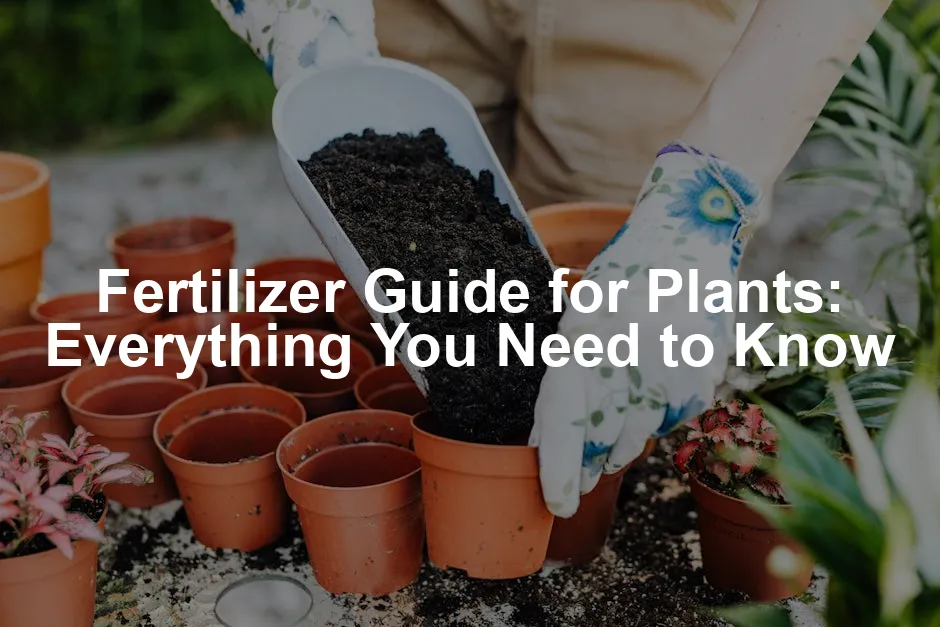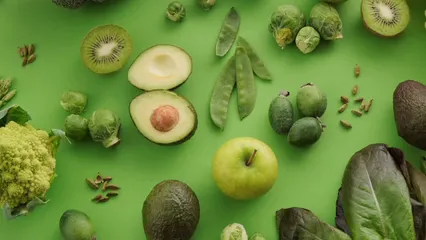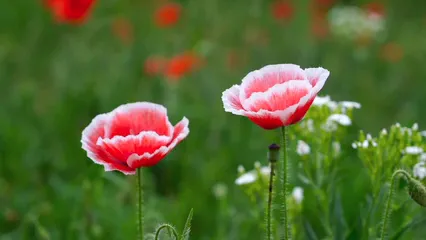

Fertilizer Guide for Plants: Everything You Need to Know
Introduction
Fertilizers are vital for plant growth and health. They provide essential nutrients that plants need to thrive. With so many types available, understanding how to use them is crucial. This guide will cover different fertilizer types, how to apply them, and best practices for effective use.
Summary and Overview
Fertilizers are substances that enhance soil fertility, supplying essential nutrients for plants. The three primary nutrients are Nitrogen (N), Phosphorus (P), and Potassium (K). These nutrients support various plant functions, from growth to flowering. NPK ratios indicate the proportion of each nutrient in a fertilizer, guiding application based on plant needs. Soil testing is crucial to determine nutrient deficiencies and ensure proper fertilization. This guide will help you navigate types of fertilizers, application methods, and best practices for successful gardening.
If you’re looking for a reliable all-purpose fertilizer, consider Miracle-Gro Water Soluble All Purpose Plant Food. This product helps your plants achieve maximum growth and blooming potential, making it a gardener’s best friend!
Understanding Fertilizers
What Are Fertilizers?
Fertilizers are substances added to soil to provide essential nutrients. They enhance plant growth by replenishing nutrients that soil may lack. There are two main types of fertilizers: organic and inorganic. Organic fertilizers come from natural sources like compost, while inorganic fertilizers are synthetically manufactured. Each type plays a unique role in plant health. Studies show that nutrient deficiencies are common in home gardens, affecting nearly 30% of plants. Therefore, understanding plant nutrition is essential for successful gardening. To ensure your plants thrive, conduct soil tests to assess nutrient levels.

Regular soil testing can help you identify nutrient deficiencies effectively. Explore our soil testing guide for more insights. And while you’re at it, why not give your plants a nutrient boost with Jobe’s Organics All Purpose Fertilizer? It’s perfect for maintaining soil quality and promoting healthy growth!
The Essential Nutrients
Macronutrients and Micronutrients
Plants rely on essential nutrients for healthy growth. The primary macronutrients are Nitrogen (N), Phosphorus (P), and Potassium (K). Nitrogen promotes lush, green foliage. Phosphorus supports root development and flowering. Potassium enhances overall plant health and disease resistance.
In addition to these macronutrients, plants need secondary nutrients like Calcium, Magnesium, and Sulfur. Calcium strengthens cell walls, while Magnesium is vital for chlorophyll production. Sulfur plays a key role in protein synthesis.
Micronutrients, though needed in smaller amounts, are equally important. Iron, Zinc, Manganese, and Copper help plants with various physiological functions. Deficiencies in these nutrients can lead to visible symptoms. For instance, nitrogen deficiency causes yellowing leaves, while phosphorus deficiency may result in stunted growth and purple tinting.

Statistics show that nutrient deficiencies can significantly hinder plant growth, impacting yield and health. Regularly checking your plants for deficiency signs can help maintain their vigor. Be proactive—monitor plant health and consider soil tests to ensure a balanced nutrient profile.
To further enrich your garden, consider adding Espoma Organic Bone Meal Fertilizer. It’s great for root development and helps in flowering, ensuring your plants are healthy and productive!
Decoding Fertilizer Ratios
Understanding NPK Values
The three numbers on fertilizer packages represent the NPK ratio: Nitrogen, Phosphorus, and Potassium. For example, a fertilizer with a ratio of 10-20-10 contains 10% nitrogen, 20% phosphorus, and 10% potassium. These numbers indicate the nutrient composition, guiding you in selecting the right fertilizer for your plants.

Different plants have unique nutrient needs. Leafy greens may benefit from higher nitrogen, while flowering plants thrive with more phosphorus. Common NPK ratios include 5-10-5 for flowering plants and 20-20-20 for general use.
Understanding these ratios enables you to choose the right fertilizer for your garden. Always consider your plants’ specific requirements when making your selection. Compare your options based on NPK values for optimal growth results.
For a boost in your garden, you might want to try FoxFarm Grow Big Liquid Concentrate Fertilizer. This potent liquid fertilizer is known for promoting vigorous growth and lush foliage, making it a top choice among gardeners!
Types of Fertilizers
Organic vs. Synthetic Fertilizers
Choosing between organic and synthetic fertilizers is crucial for your garden. Organic fertilizers come from natural sources, like compost or bone meal. They enhance soil health and improve nutrient retention. Synthetic fertilizers, on the other hand, are chemically manufactured. They often provide quick nutrient release but can leach into water systems, harming the environment.

One significant advantage of organic fertilizers is their slower nutrient release rate. This gradual process reduces the risk of over-fertilization. In fact, studies show that around 70% of gardeners prefer organic options for their eco-friendly benefits. However, organic fertilizers can be more expensive and may require more frequent applications.
Synthetic fertilizers are generally less costly and readily available. They deliver nutrients quickly, making them ideal for immediate plant needs. Yet, they can lead to nutrient imbalances or soil degradation over time.
Consider the environmental impact of your choice. Organic fertilizers contribute to sustainable gardening, while synthetic options can pose risks if misused. If you’re looking for a balanced option, try Osmocote Smart-Release Plant Food. It’s designed to provide a continuous supply of nutrients over time!
Applying Fertilizer Effectively
Best Practices for Application
Applying fertilizer correctly is key to maximizing its benefits. Timing is essential; spring and early summer are optimal for most plants. Always water before applying to prepare the soil and prevent root burn. This practice helps nutrients disperse evenly when applied.

Fertilizers come in various forms, such as granular, liquid, or foliar. Granular types work well for the soil, while liquid options deliver nutrients quickly. Be cautious with foliar feeding; overdoing it can lead to leaf burn.
Avoid common mistakes like over-fertilization. Research indicates that roughly 20% of gardeners apply too much, harming their plants. Stick to recommended amounts to ensure healthy growth. After application, water again to help nutrients reach the roots. Following a fertilization schedule based on plant needs can lead to thriving garden health.
To help you monitor moisture levels and ensure optimal fertilization, a Garden Soil Moisture Meter can be a valuable tool. It helps you know when your plants need watering, ensuring they’re not over or under-fed!
Diagnosing Nutrient Deficiencies
Signs of Nutrient Deficiencies
Identifying nutrient deficiencies in plants can be tricky but essential for their health. Look for visual symptoms to help diagnose issues. For instance, nitrogen deficiency often shows as yellowing leaves, especially in older foliage. If you notice stunted growth, it might be due to a lack of phosphorus, which can also cause a reddish-purple tint in leaves.

Potassium deficiency could present as browning leaf edges or curling. Calcium deficiency may lead to tip burn on new growth or blossom end rot in fruits. These symptoms can guide your troubleshooting efforts.
Observing your plants regularly will help you catch these signs early. A simple solution is keeping a plant journal to track growth and changes. This way, you’ll be better equipped to address any nutrient issues as they arise.
For a comprehensive guide on caring for your indoor plants, check out the Indoor Plant Care Guide. It provides valuable insights on maintaining healthy indoor plants, ensuring they thrive!
When to Fertilize
Timing Fertilization
Knowing when to fertilize is crucial for plant health. Generally, early spring is the best time to start. This timing aligns with most plants’ active growth phase. However, specific plants have unique needs.

For instance, annuals may require regular fertilization throughout their growing season. Newly planted trees and shrubs benefit from a spring application to aid root establishment. On the other hand, avoid fertilizing in late summer or fall, as this can stimulate growth that won’t harden off before winter.
Consider creating a fertilization calendar to help you remember the best times for each plant type. This approach ensures your plants get the nutrients they need at the right moments for optimal growth.
To assist in planning your garden’s fertilization schedule, consider using a Soil Test Kit for Garden. It will help you understand the nutrient levels in your soil, making it easier to determine when and what to apply!
Conclusion
In summary, understanding fertilizers is key to nurturing your plants. We explored essential nutrients like nitrogen, phosphorus, and potassium and their roles in plant health. Proper fertilization ensures vibrant growth, abundant blooms, and robust fruits. Experimenting with different fertilizers can lead to exciting discoveries about what works best for your garden. Always observe your plants’ responses and adjust your methods accordingly.

Now, we’d love to hear from you! Share your experiences and any questions in the comments below. Let’s grow together!
For those interested in expanding their gardening knowledge, consider picking up The Garden Primer by Barbara Damrosch. This book is a treasure trove of gardening wisdom!
FAQs
What is the best fertilizer for my plants?
The ideal fertilizer depends on your plant type. Look for the NPK ratio that suits your needs. Leafy greens often need higher nitrogen, while flowering plants thrive on more phosphorus. Always match the fertilizer to your plants’ specific growth stages for best results.
How often should I fertilize my plants?
Fertilization frequency varies by plant type and growth stage. Generally, feed during the growing season—spring and summer. Fast-growing plants may need monthly applications, while others may thrive with quarterly feedings. Always follow package instructions for specific guidance.
Can I use organic fertilizers for all types of plants?
Yes, organic fertilizers can generally be used across various plants. They enrich the soil and improve its health over time. However, some plants may respond better to specific nutrient compositions found in synthetic fertilizers. Always observe your plants for the best results.
What signs indicate my plants need fertilizer?
Look for yellowing leaves, stunted growth, or poor flowering. These symptoms often point to nutrient deficiencies. If your plants appear weak or less vibrant, it might be time to reassess your fertilization strategy.
How do I know which nutrients my soil lacks?
The best way is to perform a soil test. Testing kits are available at garden centers, or you can send samples to a local lab. Observing plant health can also provide clues about nutrient deficiencies.
Is it possible to over-fertilize my plants?
Yes, over-fertilization can harm your plants. Signs include burnt leaf edges, wilting, and stunted growth. Always adhere to recommended amounts to prevent nutrient imbalances and protect your plants’ health.
Please let us know what you think about our content by leaving a comment down below!
Thank you for reading till here 🙂
All images from Pexels



